-
Posts
1,065 -
Joined
-
Last visited
-
Days Won
1
Content Type
Profiles
Forums
Blogs
Gallery
Events
Store
Posts posted by Graham Stewart
-
-
GRA,
Many thanks for your input, which has cleared up that problem. The stars themselves continued to be worn right up until the Great War by members of the Territorial Force, as can be seen in the attached photo of a 1909 pattern tunic from my own collection. The TF were of course the old Volunteer Force reorganised by Haldane in 1908.
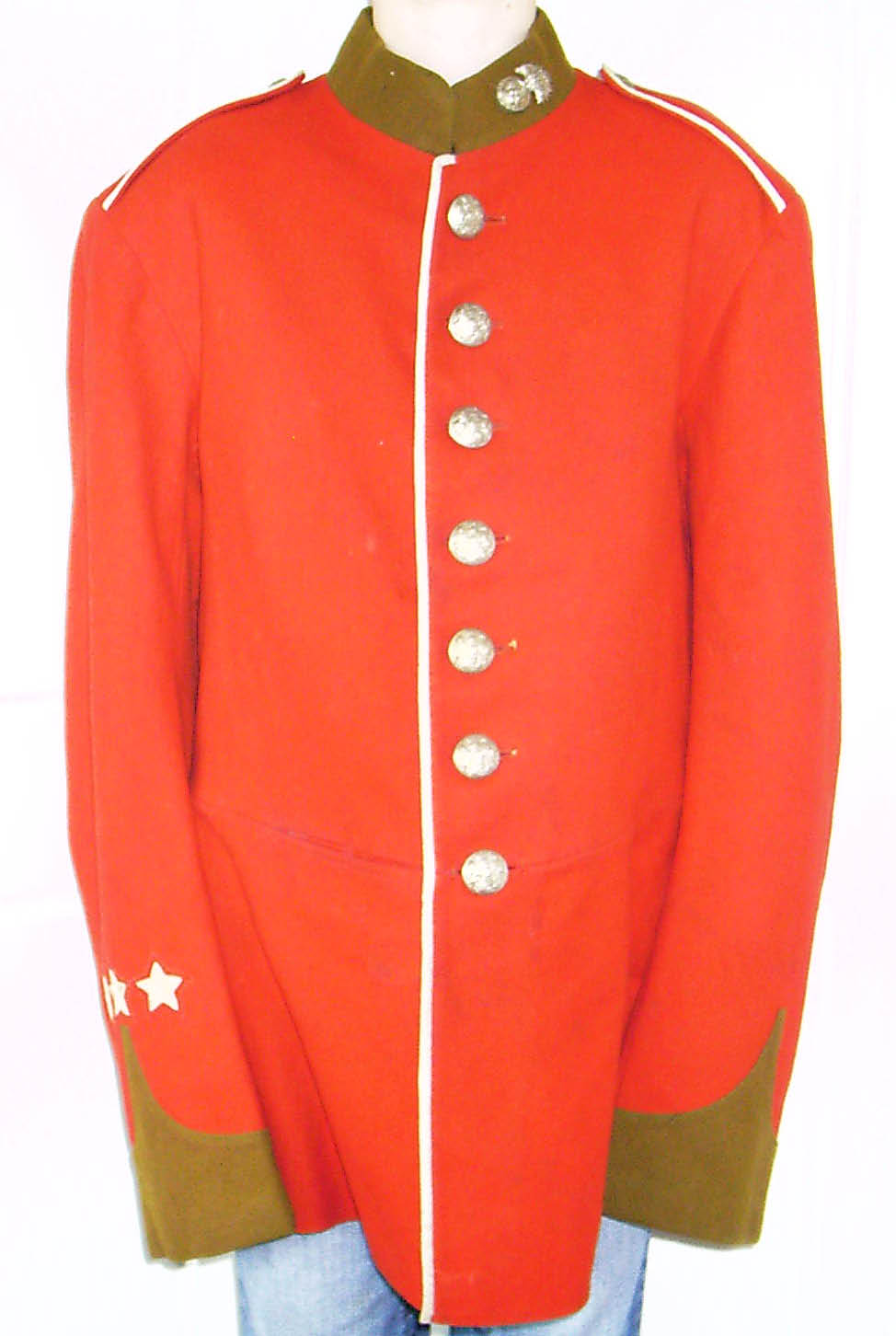
Graham.
 0
0 -
Saint,
I've seen the white band on various pre-1881 VRC photo's, most of which have no university connections and the ranks vary, but I haven't got any pre-1881 copies of Volunteer Regulations which could possibly identify its use.
Graham.
0 -
Beautiful photo and going off the fact that its a Cambridge photographer, I think we may be looking at one of the University Corps as two peculiarities have caught my eye. For instance on the cross belt he isn't wearing the Volunteer Rifles combined lionshead boss and whistle & chain. Where the whistle and chain should be located he's wearing a shield with 'pickers', which is normally associated with cavalry units and I believe the 'pickers' were to help unclog breeches on cavalry carbines.
Secondly the white band around his left cuff is most unusual and todate I can find no reference in Volunteer Regulations to determine its use, but it may be 'proficiency' orientated as later five pointed stars were adopted and worn on the same cuff above the uniform cuff braid.
Graham.
0 -
The general opinion on the pre-fix 'G/' within regimental numbers is that it stands for "General Service" to define between Regulars, Special Reserve, Territorials and New Army enlistments. It's more often associated with Home Counties Regiments although examples are found within some regiments, but not on the same scale. At a later date some Home Counties infantry units e.g. the Royal Fusiliers took to using the letter 'L/', which is believed to be 'London District'.
There's currently a major study being undertaken regarding pre-1920's regimental numbering in which I'm involved, which will probably take around a year to come together with conclusions, but what's hampering a lot of the research is the disappearance of many Regimental Nominal Roll Books and Orders referring to the subject.
Graham.
0 -
His regimental numbers are also "a*rse about face" on his MIC, as the bottom number 55399 is his original R.Berks number and the top number 5329895, is his 1920 R.Berkshire number and it was part of the new regimental block numbering system. In this case the R.Berks were issued block numbers 5328001 - 5373000.
The first number in the R.Berks 55399 is not a 1914 number either and certainly looks to be a number issued much later in the war. So this lad may actually be either a transfer or young conscript into the R.Berks opting to takeup regular service post 1918.
Graham.
0 -
T.I.
Nice photo's, a pity the technology wasn't around for digital zooming which would have really helped. The grenade in the apron is interesting as it's the huge pattern bimetal grenade, which was always disputed as being worn in the fur cap, when infact there is photographic evidence of it being worn in the fur cap. Obviously being 1RRF they appear to have a scarlet cloth backing to the grenade on the apron, whereas mine has a black backing to it. Can you recall if the pioneers in the other battalions wore different coloured backing to the grenade on the apron?
Graham.
0 -
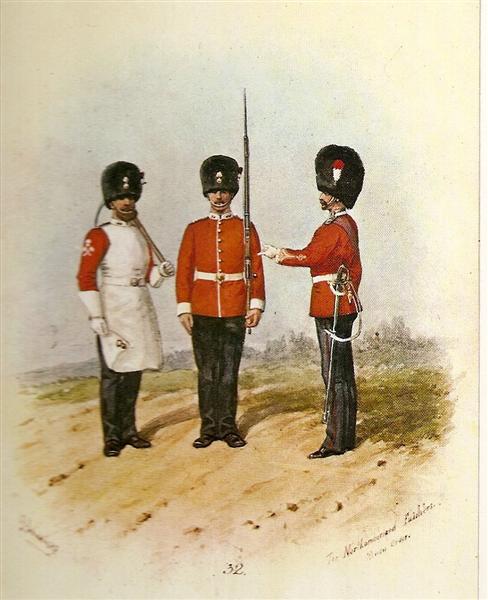
Another lovely Simkins print of 1890, showing a Pioneer wearing beard, gauntlets and apron, held back at one corner with a fur cap grenade that has a scarlet cloth backing. Note the crossed axes in white worsted above which there is also a white worsted grenade.
Graham.
 0
0 -
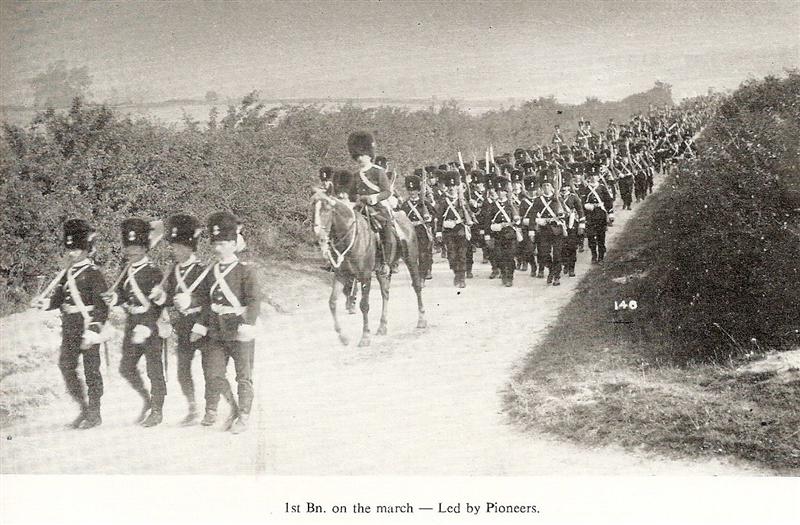
Nice photo of the 1st Bn, Northumberland Fusiliers c.1883 being led by the "four Pioneers" who are wearing scarlet frock coats with white facings to the cuff and collar. Axes are borne on the right shoulder, but no aprons are worn and leather equipment would be of the Slade/Wallace pattern.
Graham.
 0
0 -
Kev,
Very interesting as it's seems physique was the key to underage enlistment. Although it seems by mid-1915 they appear to be clamping down on it, considering the right 'who-ha' it caused in the Press and in Parliament at the time. I just wish now I'd borrowed the "I Was There" copy from my mate, in which the C.O. of the Holding Battalions talks about his job and the role of the unit with its underage lads. Certainly in my own opinion I think the scandal of underage enlistment during WWI is taken as 'gospel', when things were a lot more complicated than what we're led to believe or what people would like to believe. When writing the book 'Tyneside Scottish' with John Sheen, I did an exercise on this, which was never published in the book, and the number of those in the Brigade, who were original T.S. enlistments, who were under 20years of age at their time of death was minimal compared to those 30 plus, which was quite a surprise at the time.
Graham.
0 -
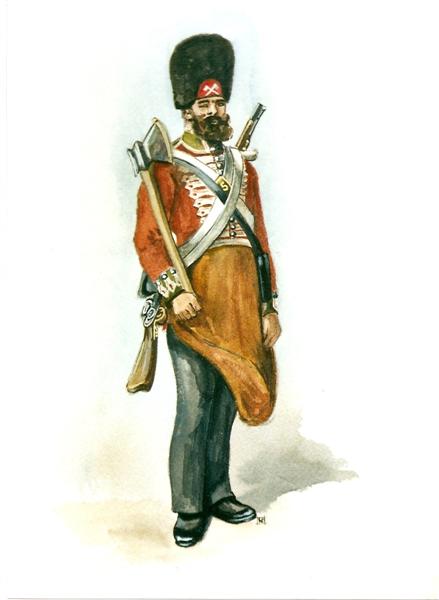
How Simkins saw the Pioneers of the 5th Foot in 1812. The current uniform doesn't bare an resemblance to that worn at the turn of the century or possibly even before the formation of the RRF. They certainly don't seem to have dressed as senior warrant officers with the inclusion of gold lace to their tunics and Standing Orders for the Northumberland makes no mention of any specail dress for the Pioneer Sgt.
Graham.
 0
0 -
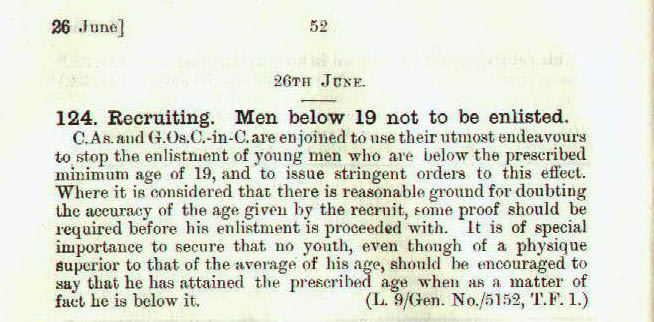
Further to earlier posts on recruitment of those under 19yrs of age for active service here is Instruction 124 of the 26th June 1915 taken from "Circular Instructions for the Territorial Force".
Graham.
 0
0 -
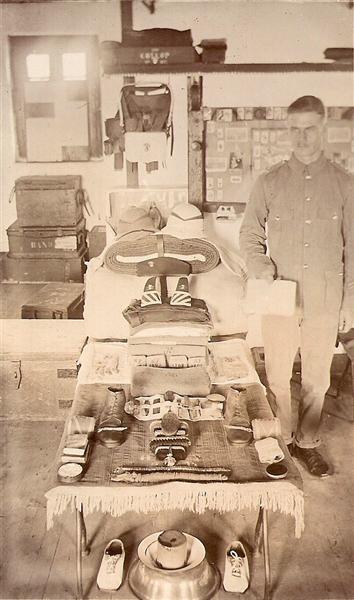
The real thing India c.1913 - 1761 Bandsman J. Gollop, 2nd Bn, Northumberland Fusiliers undergoing a kit inspection. A resident of South Shields he was to win the Military Medal on the 16th July 1918.
Graham.
 0
0 -
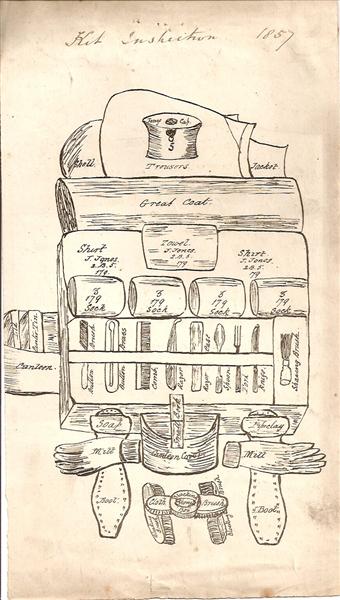
An 1857 ink hand drawn kit inspection sheet for the "Fifth Fusiliers", which would have been pinned up for recruits. The actual sheet is much larger than portayed and very skillfully put together by the unknown artist.
Graham.
 0
0 -

An interesting Memo which also appeared in his Service Records which reads;-
"Have you examined the birth certificate of this man & have the parents applied for his discharge? Unless a man is under 17yrs of age at the time of application, he must not be discharged. Please complete entry on page4 of Attestation re birth certificate."
Somewhere in my computer I have a letter appealing to the C.O. of a T.F. battalion from a widower asking for his youngest son to be returned, who has enlisted under age, as his elder brothers are already serving. The boy was returned from the Machine Gun Section, with a note from his C.O. thanking him for "his patriotism".
Graham.
 0
0 -

This young lad 6/3397 Pte Edward Spence Boocock, 2/6th Bn, Northumberland Fusiliers was discharged under KR Para 392(vi)a as previously mentioned having stated his age as 18yrs on enlistment, which wasn't true
Graham.
 0
0 -

Second ACI regarding boys as mentioned in last post. The first ACI mysteriously appeared in my last post(twice).
Graham.
 0
0 -
Leigh,
Nice photo's especially the band boys of 2nd V.B., Notts & Derby. Their shoulder titles are white worsted cotton on a red backing and they're wearing the Grey felt hat, with the khaki SD uniforms. The belt locket is probably based on a pre-1881 design for one of the Derbyshire Rifle Volunteer Corps. The 2nd V.B. Notts & Derby originally had their H.Q. in Bakewell, before it was moved to Chesterfield in 1898.
The talk of boy soldiers and the Great War has always been an emotional subject, but not all of it 100% fact. Boys did indeed enlist under age, but once caught you were dismissed under Kings Regulations 1912, Paragraph 392(vi) for "mis-statement as to age on enlistment" or Para 392(viii) "having made false answer on attestation".
A lot of parents and guardians were actually unaware that their sons had gone off to enlist and as such complained to their local MP's, as they wanted them back. This arguement eventually reached the corridors of power and Parliament put into motion a scheme in 1915 for rounding up underage boys who were serving at the front. At this period of time the age for active service was infact "19yrs of age". These boys were then taken to the rear and placed into "Holding Battalions" until such times as they could be sent to join their regiment. If a boys parents still pursued his return then he was dismissed from the Army. The story of these Holding Battalions was part of an article in the post was magazine "I Was There", which was written by the O.C.
Not all of them were rounded up because a lot especially those who falsified their ages, would not only be dismissed from the Army, but would also have to forfeit any medals due to them, no matter how long they had served. So many of them kept their mouths shut and contiued to serve.
These are facts based upon Army Council Instructions which actually deals with this subject, especially ACI's 221 of the 23rd December 1914 and ACI 148 of 15th June 1915. Once the "Upload" system has restored itself to the Forum I'll reproduce them for persusal.
The comments regarding Victor Silvester have I believe have caused some controversy to this date as I believe this "execution" he attended has yet to be proved.
Graham.
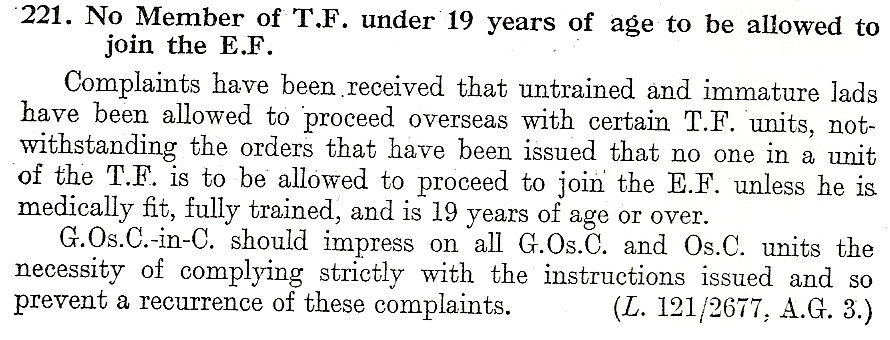
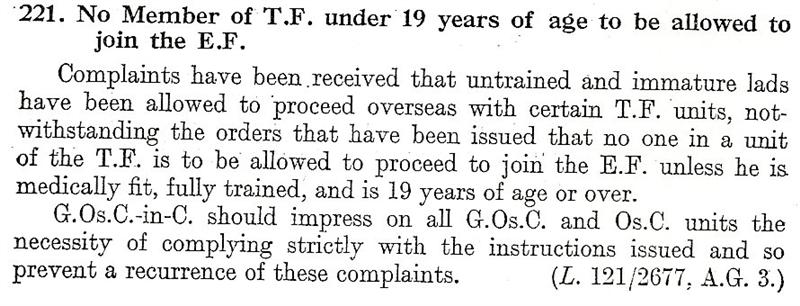

 0
0 -
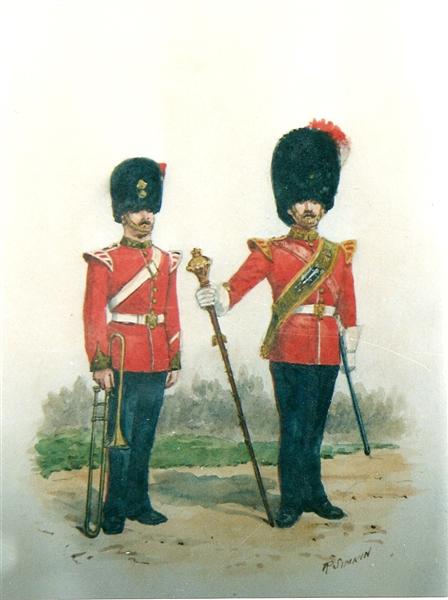
Simkins has just about got it right, but is still slightly short, but that one 'Oilette' caused many future illustrators of the NF to omit the red portion and have only the bottom white portion only.
Graham.
 0
0 -
You'll have to photo the unknown fur caps and put them on here. Fusilier officers wore bearskins, but apparently slighty smaller in height, but the height was governed by how tall you were. The original fur cap was sealskin and then they changed to Racoon. If these two items of headgear have badge holes to the front then they're more than likely Fusiliers.

Dress Regs 1900
Graham.
PS,
Will you be able to change the title of the N.I. post to R.R.F.? If you can then I'll stick on some other RRF badges and stuff.
 0
0 -
The 'Oilette' of Casey failed to show the detail of his Drum Majors plume, but not just the red over white colouring. The White portion shown is the correct length, but what they failed show was the fact that the plume followed the crown of the bearskin. In otherwords the red portion came right over the top and stopped short of coming down the right side and as Fusiliers go it was unique to the NF. If you look carefully at the illustration you'll see a dip in his bearskin at the top right, where they obviously made the mistake and it makes me wonder whether or not they were actually using a photograph to copy from and couldn't determine where the plume began and ended.
The only other unit that wore the plume in such a style was I believe the Kettle Drummer of the Royal Scots Greys
PS
Slapped wrist - they ain't busby's, they're 'bearskins', and they follow the Guards pattern and they were also worn by Fusilier officers, while other ranks wore a 'fur cap'. Busby's are worn by R.H.A. & donkey whallopers, the bag on the side of theirs being known as a 'busby bag'.
Graham.
0 -
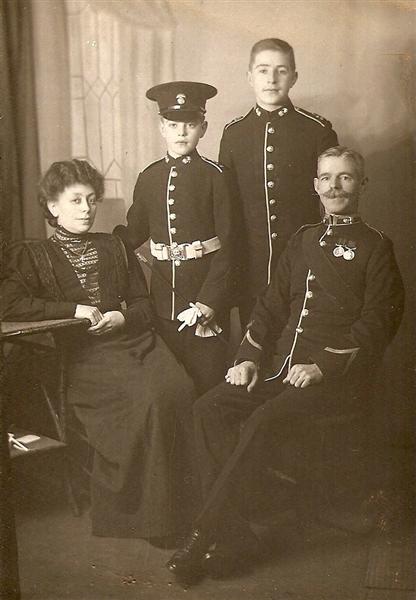
In your first post you mentioned "sons of the regiment" and here were have a good illustration of a Northumberland Fusilier family, a father, mother and two sons. The father is a Sergeant Major of an unkown regular battalion and Boer War veteran to boot. As we can see his two sons have also been enlisted into the regiment and would no doubt have followed fathers footsteps closely. Sadly I don't know the name of the family and haven't been able to pin down the Sgt Major, but given that the Great War was just around the corner one wonders what happend to the boys.
Graham.
 0
0 -
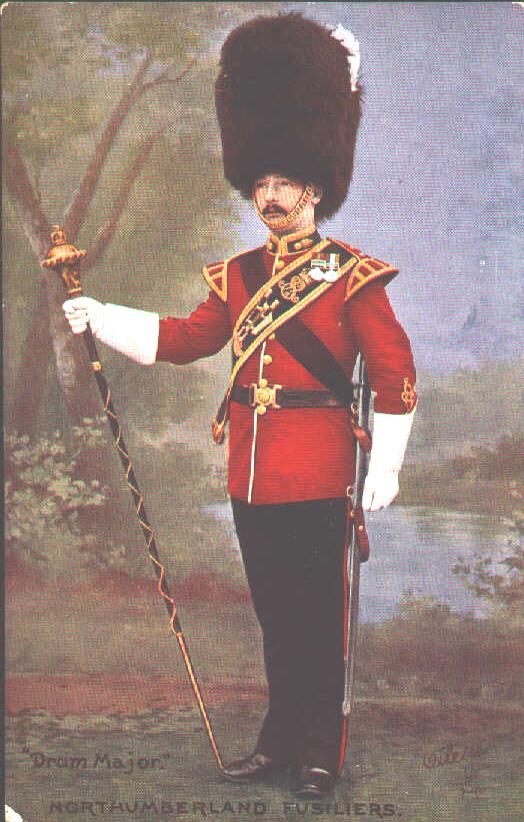
Leigh,
This is how you're more likely to see Drum Major Casey as one of Raphael Tucks 'Oilettes' No.9328.
Quiz time;- Spot the artists error?
Graham.
 0
0 -
Leigh,
Going back to the photo of the three lads with a Shipley photographers address, what you have there is formerly 245th Graduated Bn, Training Reserve who have been converted to 51st(Graduated)Bn, Queens Regt. They were based in Thoresby, Notts before moving to Sheffield, Yorks in January 1918.
Graham.
0 -
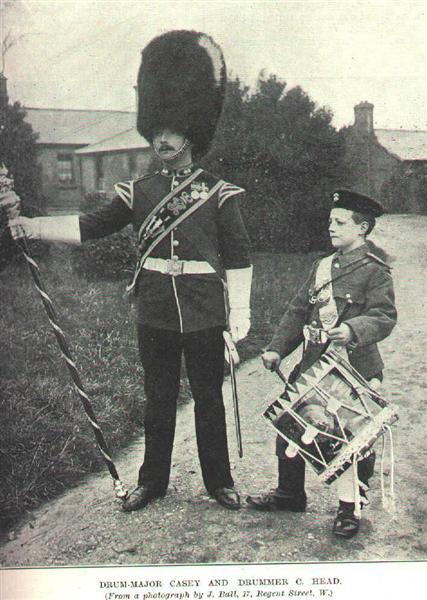
A lovely study of a Drum Major and Drummer Boy, is this case 3079 Drum Major Walter Casey and Drummer C. Head, both of the 2nd Bn, Northumberland Fusiliers taken 1903. Casey himself had enlisted as a boy in 1891 and eventually went onto become a/S.M.(later RSM) 1/7th Bn, N.F.(T.F.), taking the battalion to France in April 1915. He was later commissioned into the H.L.I. from whom he eventually retired.
Graham.
Leigh,
Anything familiar with this photo?
PS,
All Graduated and Young Soldier Battalions, which were alloted to infantry regiments were converted to 'Service' Battalions in February 1919 and sent to join the Army of the Rhine.
 0
0




The Royal Northumberland Fusiliers - (***MODERATORS' CHOICE)
in Great Britain: Militaria: Badges, Uniforms & Equipment
Posted
Tony,
Just got back from working away and saw your addition to Leighs post regarding your relative, and please except my apologies but there are some errors in the information that you have on him. Firstly he wasn't an original member of the Tyneside Scottish, he did infact enlist into the 3rd(Reserve)Bn, Northumberland Fusiliers, which is why he has a '3-' prefix to his number 3/8472. The 3rd(Res)Bn, were Special Reservists which were formed from the old Militia in 1908, although I do know for a fact that he isn't a pre-war Reservist and he is a wartime enlistment.
At the same time that number 3/8472 was issued in August 1914, again my records show that a Pte 3/8461 Pte John Devlin of Low Walker had enlisted on the 8th August 1914 and considering all regimental numbers were issued in numerical order and Devlin is a mere 11 numbers in front then it's obvious he enlisted at the same time. His place of enlistment is Newcastle, but the 3rd(Res)Bn were actually at Scotts House Camp, East Boldon, Durham, which is where most of the recruits into the battalion did their training. Nor did the battalion serve overseas as men were transferred from it to other NF Battalions.
In your relatives case it was to the 9th(Service)Bn,N.F. and it was with them that he was wounded on the 5th July 1916, which is mentioned in the Battalion War Diary. The wound was later announced in the regimental journal, but not until September 1916, but this was mainly due to the masses of Somme casualties and delays in reporting.
On recovery he moved to the 12th(Service)Bn,N.F. and was either wounded again or taken ill as he was then posted to 'A' Company, 23rd(Service)Bn,N.F.(4th Tyneside Scottish) with whom he was killed. There is a twist to this though as I believe his Medal Roll Sheet shows him again serving with the 12th Bn,N.F. after the 23rd Bn.
Graham.